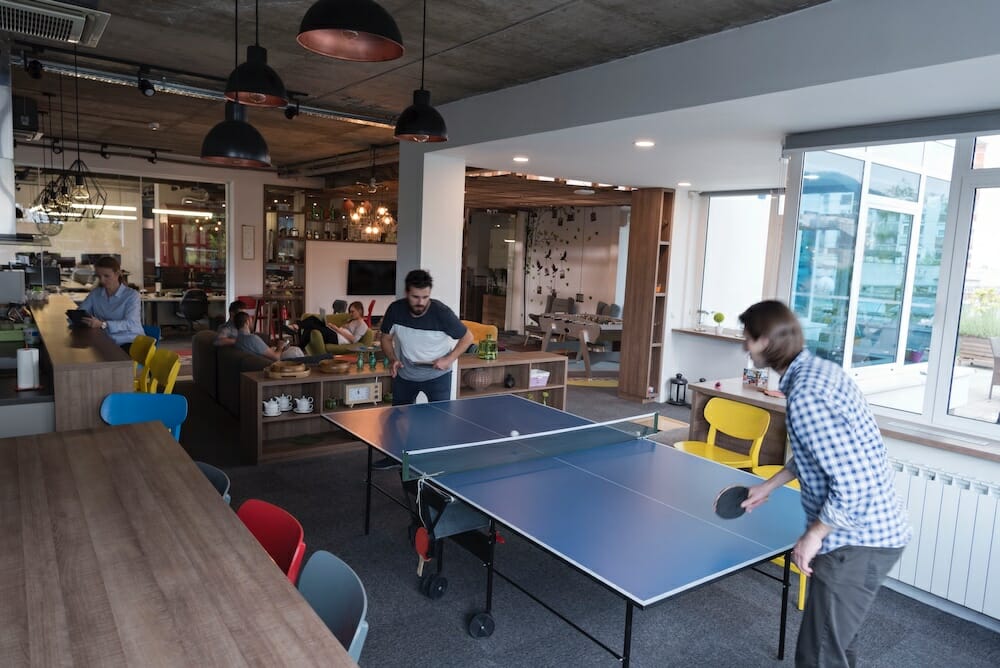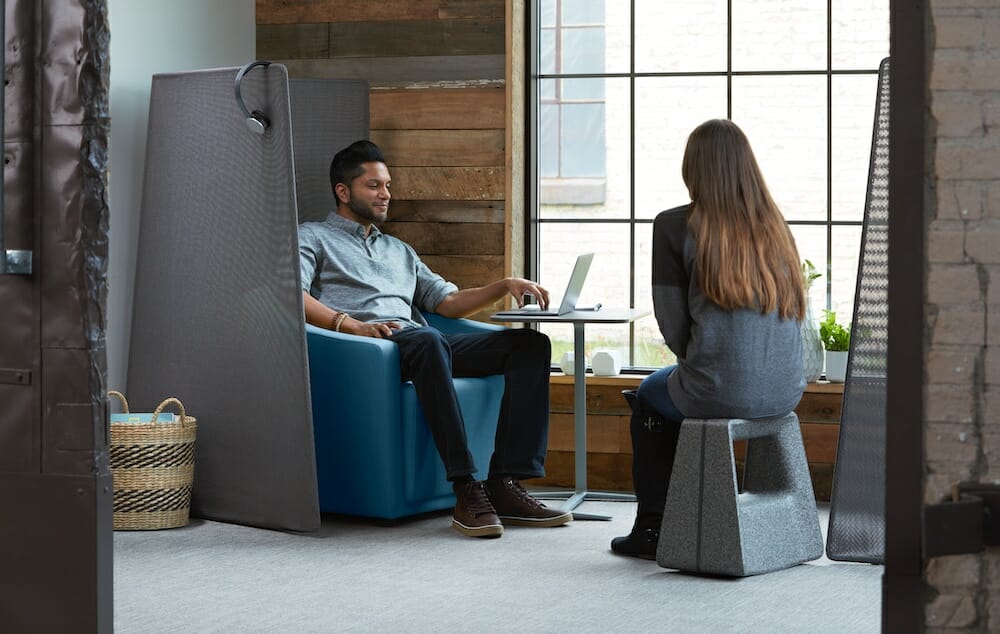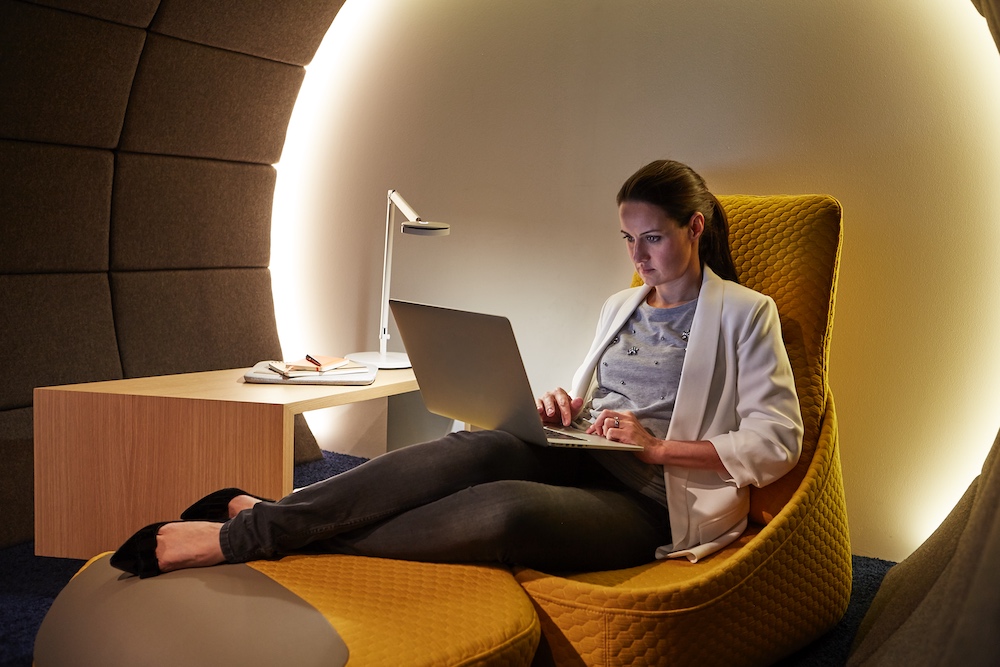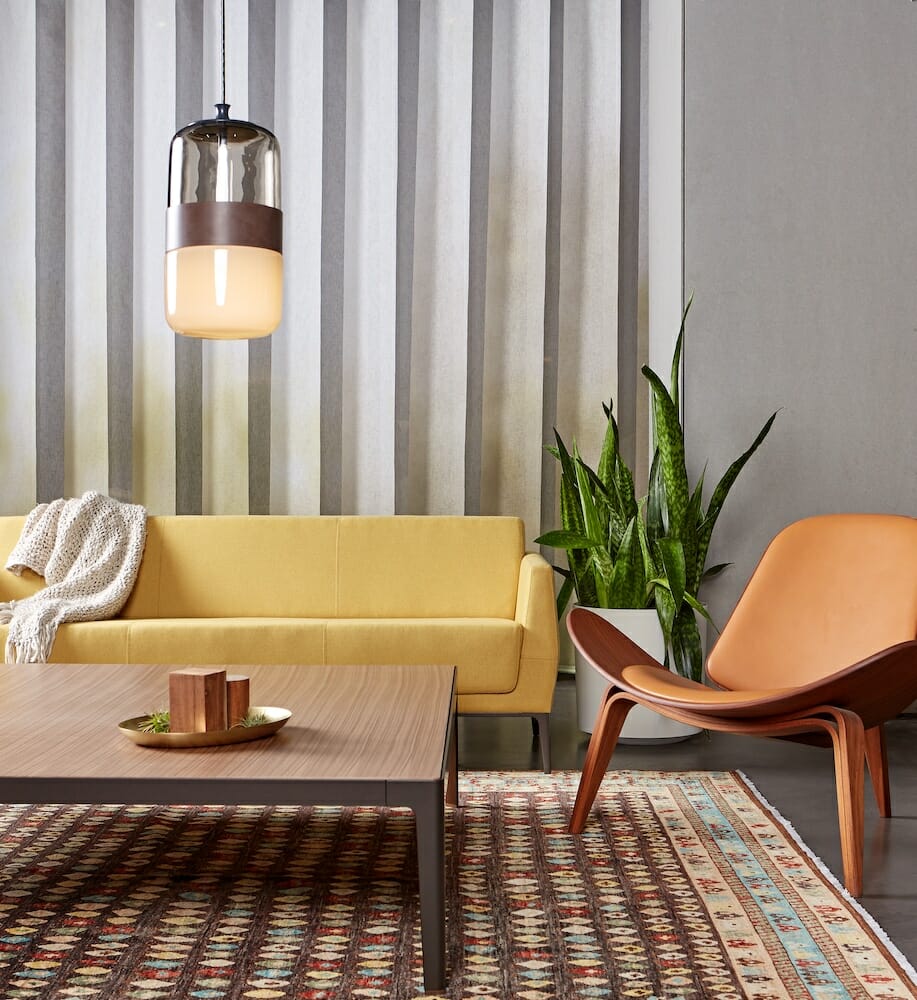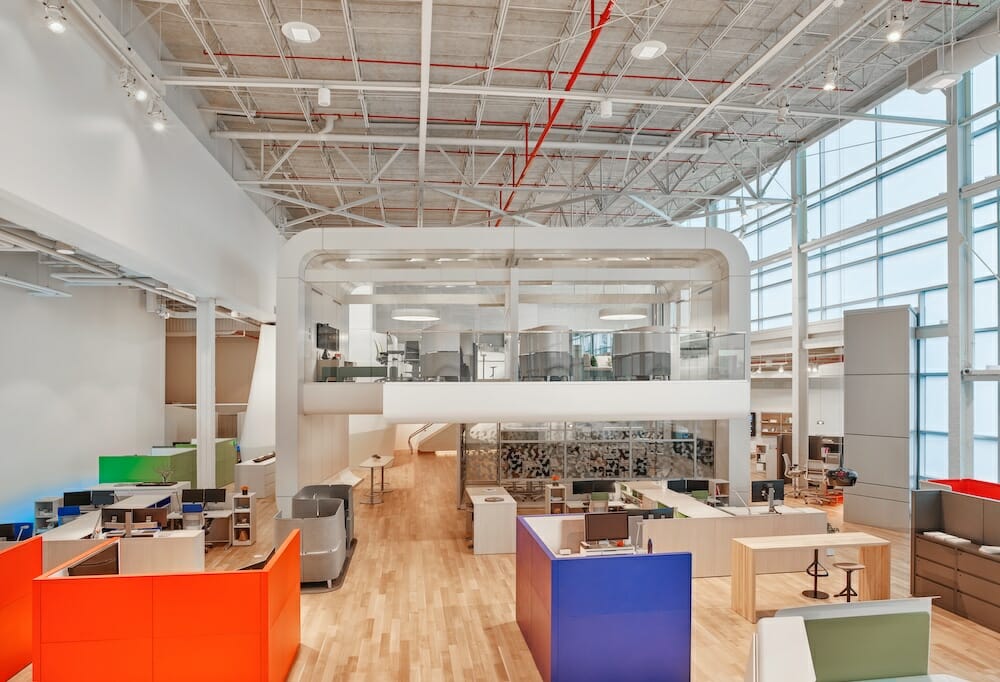The Office Renaissance
A Rebirth. And Why It Matters.
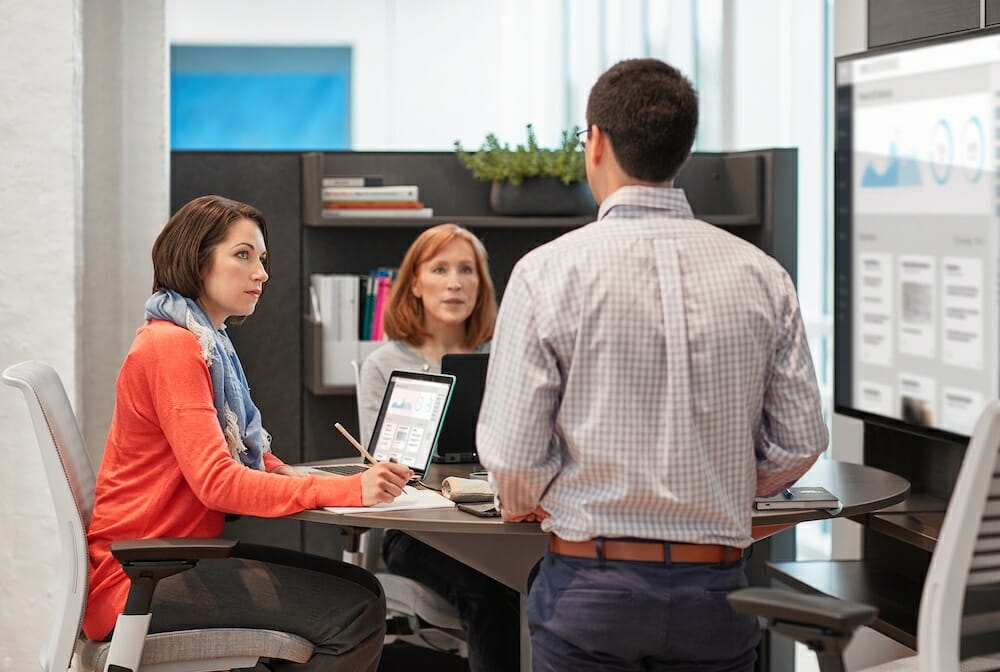
The way we work is changing, but the need to co-locate in thoughtfully designed workplaces hasn’t — we need the office more than ever.
By Christine Congdon, Director of Global Research Communications, Steelcase; photos courtesy of Steelcase
It wasn’t long after the introduction of smartphones, tablets, and ubiquitous Wi-Fi that workplace pundits predicted the end of the office. If emerging technologies allow people to work anywhere, they reasoned, then who needs the office anymore?
As it turns out, the vast majority of workers do — because work, at its essence, is a social endeavor. Even people armed with the latest mobile device still come to the office for two main reasons: to connect with other people and to access technology they can’t carry around in their backpack. The office didn’t go away, but it’s evolving into something fundamentally different.
“People are rebelling against offices that are focused on uniformity and standards,” says James Ludwig, Steelcase’s global head of design. “They’re looking for inspiration and creativity at work, as well as human-centered technology that makes life easier instead of more complicated. Designers saw this shift starting years ago, but now we’re in an accelerated evolution and those ideas are being embraced and adopted at a rapid pace.”
To understand why and how the office is changing, and to learn about how organizations can make the shift in their own spaces, we spoke with members of the Steelcase Design Studio. Based in Europe, Asia, and North America, this global team not only spotted signals of change, they’ve helped foster the office rebellion Ludwig references by offering a fundamentally different approach to workplace design that puts human beings at the center and addresses their need for emotional, physical, and cognitive wellbeing.
A Global Rebellion
Changing attitudes about the office first emerged in pop culture in the 1990s in North
America when Dilbert cartoonist Scott Adams began lampooning the workplace. Later, Peter Gibbons, a character in the 1999 movie Office Space declared, “Human beings were not meant to sit in little cubicles staring at computer screens all day!” People around the world cheered him on. Shortly after, a mockumentary television series called The Office launched in the UK in 2001, and was reproduced in the United States, France, Germany, Canada, Israel, Chile, Sweden, and China, signaling a growing global discontent with the mainstream office. The office became the symbol for wasting one’s life away in a series of bland, non-descript spaces. What happened?
Tech startups in the early 2000s were some of the first to make radical changes in their workspaces, to such a degree that many declared it a fad. Communal tables and do-it-yourself design may have been a necessity to cash-strapped entrepreneurs, but the informality and creativity struck a chord with workers everywhere. The introduction of game tables, slides, and train cars brought an element of playfulness to some offices, suggesting that maybe, just maybe, work didn’t have to be a meaningless grind, and could actually include an element of fun.
Tech startup offices were really just an early signal of greater change to come throughout the decade. After years of frustration and growing fatigue over the sea of sameness that so many offices had become, people wanted more. They looked for greater autonomy, self-expression and the freedom to choose where and how they work. Emerging technologies offered an escape route and many people voted with their feet, leaving the office whenever possible to work in alternative remote locations.
It seemed like a good idea, at first. The idea of waving goodbye to the office and working in a cool coffee shop seemed like a worker’s utopia. Until they actually did it for a while. Then people started to discover that cushy sofas get uncomfortable after a few hours, and that small coffee shop tables make it tough to spread out your stuff. Remote work proved to be a solution for workers some of the time, but not all of the time. In fact, Gallup’s State of the American Workplace report found that people who worked remotely less than 20% of the time were the most engaged. But the study also revealed that higher levels of remote work (more than 20%) correlated with higher levels of disengagement. It seems that enthusiasm for remote work was tempered by the underlying human need to seek places that offer emotional, as well as physical comfort — where it was easy to get work done. These unmet needs continued to drive people to seek something better.
Many companies look to recreate the informality and collaboration inherent to startup workspaces.
A Cultural Movement
Like any cultural movement, whether it was the 17th century “age of enlightenment” in Europe, or the current maker and farm-to- table movements, most people don’t always recognize they are in the middle of it while it’s happening. Things begin to change around us — gradually at first — and then suddenly it seems like everything is different. Forces are converging to cause both individuals and their organizations to recognize that something fundamental has to change.
“It’s like an ecosystem. Organisms in ecosystems evolve because there’s pressure on the status quo,” continues Ludwig. “And in the case of the office, there’s an ‘anti-corporate’ backlash because the term ‘corporate’ implies that a space has been created for the benefit of the organization, not the person. So it’s putting pressure on the system to change. The design challenge is to meet business needs while we’re serving the needs of human beings.” Participants in the Steelcase/Ipsos employee engagement study offered candid feedback about what needs to change in their workplaces – the most common complaint was lack of privacy. “The noise level is distracting,” one worker wrote. “It’s very difficult to concentrate and to hear when on phone calls.” Another worker wants “a more private space … to do my work without interfering with anyone else.” Both introverts and extroverts are asking for an option to escape and concentrate.
The design team also notes that the desire for emotional comfort sometimes leads people to make choices that don’t support their physical comfort or ability to perform. The coffee shop might have a great vibe, but isn’t always the best work environment if the chairs are hard, the tables small and the lack of power outlets frustrating. “I don’t think we’d want our living room in the workplace,” says Bruce Smith, Steelcase’s Director of Global Design. “I think what we want is something that’s human and relevant and that will spark creative ideas.”
Like any complex issue, there is no single right answer for every person or organization. Cherie Johnson, Global Design Director, counsels organizations to think about “purposeful placemaking.” “You need to understand how and why people use a space, and then create spaces to reflect clarity, simplicity, and purpose,” she says.
How Do We Get There?
Traditionally work has been thought of as a mostly rational, logical process in which emotions could influence decision making in potentially worrisome ways. New research, however, illuminates the connection between emotions and cognition, as well as physical wellness, and validates the role of human emotions in achieving business success. Traditional workplace metrics, such as real estate costs or productivity, are being reframed by a deeper understanding of human behavior at work using insights from neuroscience that shed light on what motivates people to achieve more.
“Thinking about space through the lens of wellbeing, takes a very holistic and humanistic approach,” notes Johnson. “The problem is that offices designed with old business metrics were all about efficiency, and the human being got lost in the process. It led to a lot of work environments that were cold and sterile, and did not help achieve the business goals organizations were aiming for.”
Design for Emotional Wellbeing
Our research synthesis notes six dimensions of emotional wellbeing that can be impacted by the design of the physical environment. When these dimensions are considered, people will feel a greater connection to their organization and become more resilient:
Optimism is critical to the type of work that organizations need today: creativity and innovation. It influences a wide range of behaviors such as seeing the big picture, exploring ideas, being open to others, taking more risks, and facing difficult tasks. It also makes people open to change.
The focus on mindfulness in business has grown exponentially as organizations recognize that rapid changes in technology, the marketplace, and the global playing field have caused volatility, uncertainty, chaos, and ambiguity. “Workers need physical spaces that help them manage the cognitive overload of their daily lives and be fully present in the moment,” notes Nicholas de Benoist, Steelcase’s Director of Insight Led Experience.
Wellbeing is cultivated by personal expressiveness — the freedom to be who you are, at work as well as away from work.
A meaningful life means feeling connected to other people. Relationships anchor our commitment to an organization, its brand, and its purpose. Because of this, mobility, alternative work strategies, and telepresence across geographies must be intentionally crafted so that employees don’t lose their sense of belonging.
People need to use their strengths, understand their impact, and see how they contribute to organizational goals. “How we spend our time, doing the right things in the right way, can powerfully impact wellbeing,” says de Benoist. “Spaces that are intentionally designed to help people accomplish meaningful goals can make a tremendous difference in individual performance and overall organizational results.”
Scientists continue to discover how the mind and body function as an interrelated system. We know engaging the body in movement at work is essential for supporting mental and physical vigor. Sensory experiences in work environments are important, too. Light, sound, touch, and other stimuli all influence our mind and body.
Design for Cognitive Wellbeing
In addition to feeling great about going to work every day, employees want to be able to perform well and think clearly once they are there. Unfortunately with near-constant distraction a way of life, cognitive wellbeing is under assault. Email, instant messaging, social media, texting, phone calls, apps, it’s all just too much. According to the University of California- Irvine, the average office worker is interrupted or distracted every three minutes. At times, focus and productivity can feel elusive.
Fortunately, the research of neuroscientists in more than 40,000 labs throughout the world is shedding new light on the processes of attention and, in so doing, providing decipherable clues into how it can be supported in the workplace.
Part of the problem of distraction, and the solution, lies in ourselves. By changing our existing habits, we can gain more control of our brains — and our lives. We have identified three brain modes that each require distinct behaviors and settings.
When we need to deeply focus on something, it’s important to avoid unwelcome distractions. Whether the distractions are external or internal, everytime we switch our attention we burn through finite neural resources and increase opportunities for our focus to be hijacked. Design can leverage acoustical, visual, and psychological boundaries to support focus. Layers of boundary — from fully enclosed spaces to micro lounge settings — enable users to control external stimuli.
Although daydreaming has taken on generally negative connotations in the working world, as it turns out our brains are still working when they wander, building connections and searching for inspiration. “The neurons are forging new pathways versus focusing on what you already know. And that’s when insights really start developing,” says Donna Flynn, Steelcase’s Vice President of the WorkSpace Futures team. A social zone such as a cafe at an intentional crossroad, a lounge space promoting relaxed conversations, or a more private area to allow employees to take a deep breath, all support cognitively- overwhelmed workers’ needs to rejuvenate.
When we need to activate our brains, moving our bodies is the key. Numerous studies have proven that movement boosts attention by pumping oxygen and fresh blood through the brain and triggering the release of enhancing hormones. Settings that provide workers opportunities to stand-up or walk refresh the mind and the body. High-sit tables, and Walkstations, integrated treadmill, and work surfaces, are just a few examples of design results tied to improving cognitive wellbeing.
Design for Physical Wellbeing
During the past 50 years, most jobs have become more stationary and obesity rates are rising. Less activity at work has been identified as a key contributor to the rise of obesity in America. Physical wellbeing in the workplace is promoted by making movement intentional and supporting the body in a variety of postures. A shared ecosystem of spaces in the office gives employees choice and control over where they work and encourages movement from one part of the building to another. Together, conference areas, team spaces, lounges, and a cafe can get people moving and interacting more.
By offering a variety of postures such as sitting, standing, or lounging, employees are encouraged to move around and re-energize the body. And if people do have to spend a lot of time sitting; supportive, ergonomic seating is intended to offer active sitting. Active sitting works with the body in any posture, and is flexible as the body moves. You can recline knowing your work surface will stay within reach and your back and spine will be supported.
Workplace Wellbeing Strategies
When designing spaces that support the interconnectedness of emotions, physical health, and people’s ability to think and solve
problems, our team at the Steelcase Design Studio suggests six overall strategies that can help achieve the right balance:
- Democratize space: Similar to a healthy ecosystem in nature that is biodiverse, create a range of spaces that support different work modes that people can choose to work from, regardless of where they fit within the organization’s hierarchy.
- Support multiple postures and movement: incorporate spaces that allow people to work in whatever posture works for them – lounging, standing, perching, walking, or sitting upright.
- Take cues from nature: More than just adding plants – which is important – seek variation over uniformity. Incorporate naturally complex materials, a plurality of shapes, forms, patterns, and textures.
- Embed performance: The most inviting and inspiring spaces need to help people make meaningful progress on their work. Integrate technology that makes it easier for people to collaborate, that encourages movement and makes it easier to get into focus. Help people find their favorite places to get work done and provide a feedback loop to the organization about what spaces work.
- People need privacy: Balance the desire for openness with the human need for solitude. Create spaces that support focused work as well as rejuvenation.
- Promote personalization: Create spaces that feel customized to the organization and the individual. Prioritize self-expression and authenticity over perfection.
When thoughtfully combined, design, materiality, and performance blend a more human experience at work with the ability to still get the job done. These spaces create a genuine atmosphere that give people the freedom to choose where and how they work and always perform at their best.
Office environments that mirror the materials, finishes, and lighting of home help create authentic spaces for socialization.
Where & How Work Happens Has Changed
Rapid advances in technology allow people to work anywhere, anytime — which led to people working everywhere, all of the time. It’s clear that the old paradigm, one person working almost exclusively in one individual workspace, does not support the ways people are working today. Steelcase designers and researchers exploring the office renaissance point to the key forces accelerating change.
Shift to Creative Work
New pressures to compete and grow businesses shifted organizational emphasis toward work that requires creativity and a new innovation process. “Breaking rules and breaking patterns is where new ideas come from,” notes Bruce Smith, Director, Global Design. Many workplaces were designed to support an outdated process, and did not make spaces for creative collaboration a priority.
The War for Attracting & Retaining Talent
Employees with coveted 21st century job skills, who can help organizations innovate and grow, are a limited commodity. They often choose organizations that offer the most meaningful work, and the best working conditions, rejecting anything that makes them feel like a cog in the wheel of industry. This is true for both attracting new employees as well as retaining existing ones.
Employee Disengagement
Over one-third of workers in 17 of the world’s most important economies are disengaged, according to Engagement and the Global Workplace, a study conducted by Steelcase and global research firm Iposos. The study found a positive correlation between workplace satisfaction and employee engagement; the most highly disengaged workers were also the most unsatisfied with their work environments, citing they did not feel a sense of control over where and how they work.
The Promise of Technology
Consumer technologies are a game-changer for the office. People leave smart homes and drive smart cars into offices that, for the most part, offer little in terms of technology to help them work and feel better. The internet of things, a concept in which essentially anything electronic – home appliances, watches, etc. – is connected to the internet, is something people have come to expect in their personal lives and opens new possibilities at work.
Strategy at Steelcase HQ
For more than 20 years Steelcase has researched the changing nature of work, including the explosion of technology, an overload of information, and the global and mobile nature of communication. We’ve designed prototypes to test theories and push the boundaries of how work happens, resulting in radically reimagined ways of working, both as individuals and teams. The latest research has identified how physical space can impact how people feel in the office and, in turn, how people perform at work.
When it came time for Steelcase to reinvent their global headquarters campus in Grand Rapids, MI, designers envisioned a bold plan. In an era where people can work from anywhere, they decided to leverage global research and design principles to create an office where people desired to come to work every single day — a spaces where people could have fun and function at the same time.
The essence of this strategy is best place. “It means you have a choice and control about when, where, and how you work, so whatever your work requires, there is a best place for you,” says Cherie Johnson, whose team led the design process for our new campus.
The best place strategy supports the wellbeing of employees in a holistic way, considers emotional, and cognitive needs as much as physical ones, and results in a range of spaces that support the varied ways knowledge workers work today: focusing, collaborating, learning, socializing, and rejuvenating.
Prioritize Social Spaces. One of the most important new spaces is the WorkCafé, an on-site “third place” and neighborhood crossroads. The headquarters campus is the neighborhood and the WorkCafé is its hub, a combination workspace, cafeteria, and coffee bar. It has the easy functionality of a well- planned office with the vibe of a neighborhood pub. Here people meet, work, network, socialize, and reenergize.
Most workplace strategies focus on individual workspaces first, but Steelcase’s best place strategy put the WorkCafé front and center. A prototype space, it was the first to open on campus and popular from the start. “Everyone comes here. You see leadership, people from other parts of the company, visitors, customers. You meet people face-to-face instead over the phone or email, so it builds rapport and trust across the company, and it nurtures those qualities in your culture,” says Johnson. “It set the tone for the rest of our campus reinvention by giving everyone the opportunity to experience what democratizing the space means, in a collective way, before anyone had their own personal spaces changed. It reflects the culture and behaviors we want people to adopt.”
Give Employees Control. Research showed engaged employees have more control over where and when they work. Before Steelcase’s reinvention, 95% of people had assigned desks. But not all employees needed or wanted an assigned workstation. Volunteers came forward to try mobile work. In fact, nearly half (45%) chose to give up their dedicated workspaces in exchange for more flexibility. Since the changes have been implemented, the number of employees opting for a mobile workstyle has continued to increase.
Despite the desire for mobility, the Steelcase Global Report showed fixed technology continues to exceed mobile. Eighty-six percent of global workers surveyed reported having a landline phone and 80% a desktop computer. Compare those statistics to fewer than 40% worldwide who say they are equipped with a laptop or cell phone.
Those realities mean more work still needs to get done in the office. The choice and control over where to work cannot end at the office doors. It needs to continue inside the workplace where people need options for individual spaces to focus and rejuvenate, and team spaces for brainstorming and collaboration.
At our campus, in addition to the WorkCafé, designers presented employees with an ecosystem of spaces from which to choose. For example, employees can choose a Walkstation treadmill desk to support movement, a privatized lounge space to focus, or a small conference room equipped with telepresence to make it easy to connect with counterparts oceans away.
A Better Way of Working. The new global headquarter’s workspaces are already contributing to a better way of working. While mobile work was not uncommon before the new spaces opened, best practices for mobile workstyles, such as how workers can best collaborate with distributed colleagues, or how to keep all members of a project team fully engaged, were not common knowledge. Thanks to a combination of workplace support and changed behaviors, mobile work is no longer an issue for the organization, according to company leaders.
Other aspects of the culture have also changed. Employees reported a 3.5% boost in engagement in three years. That’s a big shift in such a short period of time. Similar gains were seen in worker performance and external orientation, a critical success factor for becoming more globally integrated.
Dave Sylvester, Steelcase’s Chief Financial Officer, says feedback from his organization is “off the charts.” Half of his staff are mobile, choosing shared benching workspaces as their daily home base, and 62% report their workplace helps attract and retain employees.
Most importantly there is a feeling of vitality, belonging, and meaning at Steelcase, enticing employees to give their best each and every day. “We know that people don’t remember much about the words they hear in mission statements or strategy documents,” says Steelcase CEO, Jim Keane. “Instead, they make sense of the company’s direction and purpose — and their place in it — by interacting with other employees and reading the cues signaled by the environment. Our new work environments have changed us as an organization. It’s obvious to everyone, including visitors to our spaces who tell us they can sense the essence of our culture and brand through the space.”
From Design Museum Magazine Issue 002
Design for Emotional Wellbeing
Design Considerations
Optimism
- Allow choice and control over where and how people work
- Create spaces that allow personalization and individual customization, instead of tightly enforced workplace standards
- Offer settings and affordances that help employees feel supported in their work
- Design for transparency, so people can see and be seen, and build trust
Mindfulness
- Create spaces that help people connect with others one-on-one and eye-to-eye, and not just through their technology devices
- Design areas that allow workers to control their sensory stimulation and choose if they want to turn it up or down
- Offer places that are calming, through the materials, textures, colors, lighting, and views
- Create areas where people can connect with others without distractions or interference
Authenticity
- Create spaces that help people feel comfortable to express themselves and share their ideas
- Incorporate informal, non-constricting environments with a home-like feel
- Design areas that help people connect their personal values to the brand values
Connecting with Others
- Create entrances that are welcoming with visible hosting for people who don’t work there routinely
- Provide ample and well-equipped spaces for mobile and resident workers to work individually or in teams
- Offer video-conferencing configurations that allow remote participants to see content in the room and on the walls, and to hear everyone equally
- Design informal areas for socialization, in person as well as virtually
A Sense of Purpose
- Include spaces beyond the lobby that reinforce the brand, purpose, history, and culture of the company
- Leverage vertical real estate to make thinking and progress visible
- Use technology to display real-time info
- Create an ecosystem of spaces that give people choices and empower them to work productively alone or together
Vitality & Movement
- Design areas that give people choices for controlling the level of sensory stimulation around them
- Provide easily adjustable furniture to fit a range of sizes, needs, and preferences and to promote movement throughout the day
- Include cafés with healthy food choices and displays
